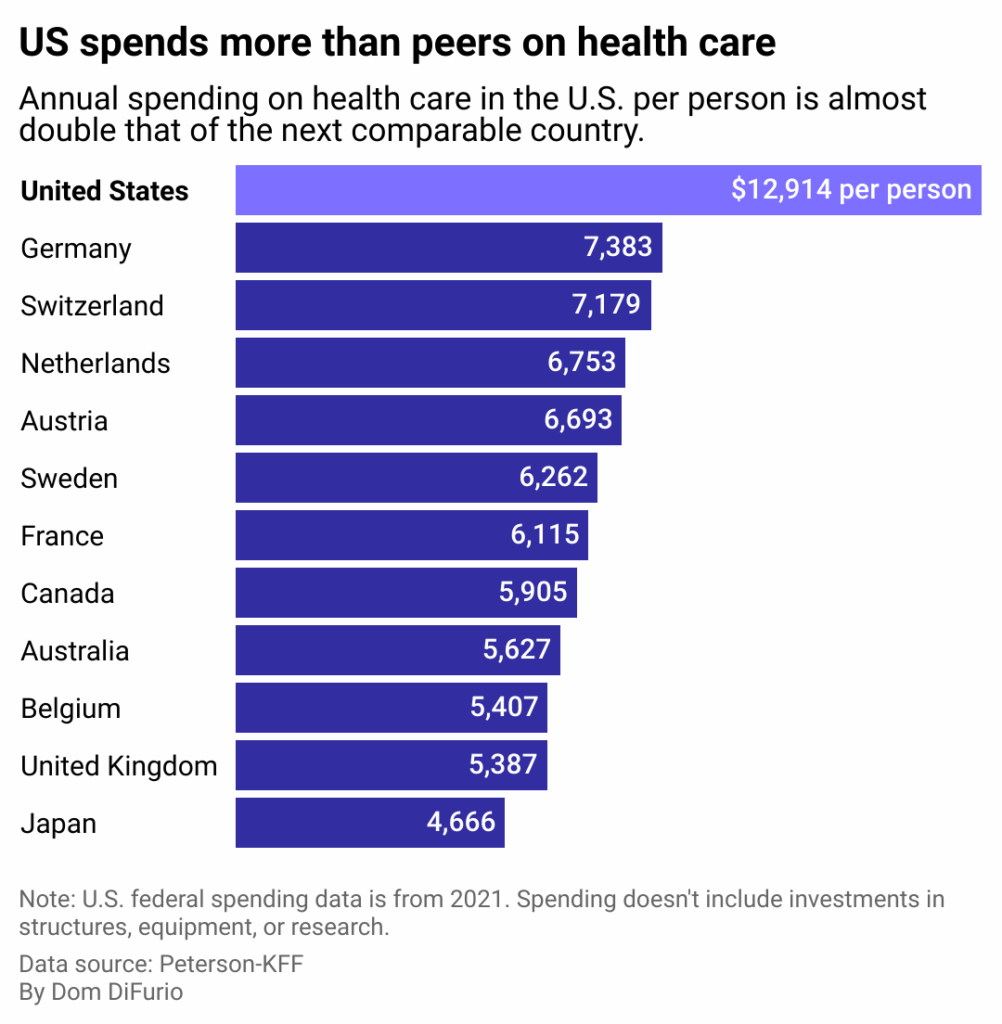The Maine Medical Association, a professional organization of about 4,000 doctors and medical students, formally called for universal health care insurance coverage in September. The group joins four other medical associations and several advocacy groups representing the state’s physicians, and they are urging lawmakers for a national system-wide overhaul.
DocBuddy analyzed statements from the growing number of medical associations calling for an overhaul of the private health care system to shed light on the recent push for universal health care since the COVID-19 pandemic.
The nation’s uninsured rate reached an all-time low in the first three months of 2023, with 7.7% of U.S. residents lacking health insurance, according to the National Health Interview Survey from the National Center for Health Statistics. The COVID-19 stimulus bill, nicknamed the American Rescue Plan, provided subsidies that dramatically lowered costs and administrative barriers to coverage. Millions of Americans, however, remain uninsured.
The Maine Medical Association—alongside the Hawaii, Washington, New Hampshire, Vermont, and Washington D.C., associations—point to universal health care coverage as the long-term solution. Universal health care would ensure all residents can receive medical treatment without financial hardship, the associations say, and also reduce costs, level the playing field for patients, and provide comprehensive care.
Opponents say a universal program would lead to longer wait times for important medical appointments, create critical staffing shortages, and limit opportunities for elective surgeries.
ALL YOU NEED TO KNOW ABOUT OPERATIVE REPORTS
Get the basics for what constitutes an operative report and what needs to be included within one.

US spends more on health care than comparable nations
Compared to similar wealthy and large countries, the U.S. spends the most per person on health care. In 2021, the U.S. spent $12,914 per person, according to National Health Care Expenditure data and KFF, while Germany, which spent the second most, paid only $7,383.
That spending can translate to debt on an individual level. A 2017 Census Bureau survey found that 19% of households carried medical debt, with Black and Hispanic households likely to carry even more.
All that extra spending doesn’t necessarily translate to better outcomes. The U.S. has the lowest life expectancy among 10 peer countries. The average American can expect to live 76.1 years, compared to an average of 82.4 years in similarly wealthy countries in 2021.

US health care inequality
Even though the majority of Americans have health insurance, high out-of-pocket costs create a barrier to getting medical care. Almost 1 in 10 adults either did not seek medical care or delayed it due to cost. Hispanic people and those with low incomes are the most likely to forego medical care due to the costs, according to a KFF analysis of a National Health Interview Survey.
U.S. residents also face disparate outcomes based on their sex, race, ethnicity, gender identity, or ZIP code. American Indians and Alaskan Natives have shorter life expectancies compared to white people. During the COVID-19 pandemic, Black people had a larger life expectancy decline than white people. Also, Black infants are more than twice as likely to die as white infants, according to the Department of Health and Human Services.
High medication costs force some low-income residents to make the choice of paying for their medication or necessities like housing.
The Vermont Medical Society’s Resolution calls for “affordability for all, including no cost-sharing (no premiums, copays or deductibles), a ban on investor-owned health care facilities, and prescription drug prices to be negotiated directly with manufacturers.”

Current US system is inefficient
According to the medical associations, this extra spending is, in part, due to the additional administrative burden American doctors now face. The current U.S. health care insurance system is a hodgepodge of taxpayer-funded health insurance offerings, like Medicare, and private insurers, requiring medical staff to process an immense amount of paperwork.
“Competition among private health insurance plans in Hawaii has resulted in reduced [payment for doctors], increased managed care paperwork and bureaucratic requirements, increased administrative costs, and increased obstacles to payment of claims for physicians,” the Hawaiian Medical Associates House of Delegates wrote in its 2008 resolution for single-payer health care.
Scientific studies back up their claims. More than $1 in $4 spent by U.S. hospitals went toward administrative costs, according to a 2014 study published in Health Affairs. Researchers estimated that if U.S. hospitals reduced their administrative spending in 2011 to Scottish or Canadian levels, U.S. hospitals would have saved more than $150 billion.
Both Scotland and Canada operate a form of coverage called “single-payer” health care, where hospitals and doctor’s offices are largely privately run, but doctors bill only one insurance provider, the government, for any essential services they provide.
WHAT IS AN OPERATIVE REPORT?
Find yourself asking “what is an operative report?” Here is all the information you need to know and more.
Current US system is inefficient
According to the medical associations, this extra spending is, in part, due to the additional administrative burden American doctors now face. The current U.S. health care insurance system is a hodgepodge of taxpayer-funded health insurance offerings, like Medicare, and private insurers, requiring medical staff to process an immense amount of paperwork.
“Competition among private health insurance plans in Hawaii has resulted in reduced [payment for doctors], increased managed care paperwork and bureaucratic requirements, increased administrative costs, and increased obstacles to payment of claims for physicians,” the Hawaiian Medical Associates House of Delegates wrote in its 2008 resolution for single-payer health care.
Scientific studies back up their claims. More than $1 in $4 spent by U.S. hospitals went toward administrative costs, according to a 2014 study published in Health Affairs. Researchers estimated that if U.S. hospitals reduced their administrative spending in 2011 to Scottish or Canadian levels, U.S. hospitals would have saved more than $150 billion.
Both Scotland and Canada operate a form of coverage called “single-payer” health care, where hospitals and doctor’s offices are largely privately run, but doctors bill only one insurance provider, the government, for any essential services they provide.
WHAT IS AN OPERATIVE REPORT?
Find yourself asking “what is an operative report?” Here is all the information you need to know and more.

The downsides to universal health care
Undertaking any form of universal health care would mean a potentially complicated transition phase for patients, health care providers, and government overseers. Government agencies would likely have to expand, and new ones may need to form to handle the new caseloads and paperwork. Patients who have grown used to their insurance company’s offerings and payment scales may see their coverage options shift.
According to a 2020 review in the journal Medicine, the cost of such a health care system would mean higher federal taxes, most likely for those in the higher income brackets. The review also notes, however, that a healthier population that has access to preventive and medical care could lower chronic disease and “help to mitigate the economic costs of an unhealthy nation” in the long run.
On the providers’ side, some worry that universal health care or a single-payer system would enhance government oversight, restrict what treatments they can offer patients, and stifle innovation.
More patients seeking health care could also mean longer wait times and the overuse of services. If patients don’t have to worry about the cost of health care, they may insist on an extra X-ray or take that extra medication, even if their provider says it’s unnecessary.

There are a few different routes to establishing universal coverage
While the medical associations call for some form of government-funded health care system, there are different ways to ensure universal coverage.
The federal government could continue the current system, which operates largely on private insurers, but expand systems like the Affordable Care Act marketplace so everyone can be insured for little to no cost. It could also begin regulating the cost of care and medications. Or, the government could set up a “single-payer” system, where all doctors and health care providers would bill only the government for their services.
Countries with single-payer systems often allow residents to purchase additional private insurance and pay more to “skip the line” for faster care or more amenities.
STOP WASTING TIME WRITING OP REPORTS
No more delays and wasted time in the operative report process using this fantastic Op Note template.

Fifty-seven percent of American adults think it is the federal government’s responsibility to make sure Americans have health insurance coverage, according to 2022 Gallup data. However, they prefer the system to be based on private insurance instead of being operated by the government.
Meanwhile, 80% want the government to lower drug prices through negotiation, according to an AP-NORC poll conducted in 2022. President Joe Biden took the first steps in that direction earlier this year when he identified 10 commonly used prescription drugs for Medicare’s first price negotiations.
Written by: Cassidy Grom. Story editing by Ashleigh Graf. Copy editing by Kristen Wegrzyn. Photo selection by Clarese Moller.
